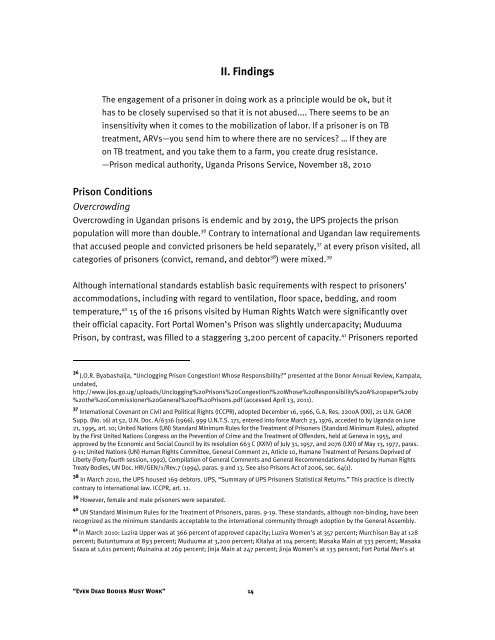Even Dead Bodies Must Work - Office of the High Commissioner for ...
Even Dead Bodies Must Work - Office of the High Commissioner for ...
Even Dead Bodies Must Work - Office of the High Commissioner for ...
You also want an ePaper? Increase the reach of your titles
YUMPU automatically turns print PDFs into web optimized ePapers that Google loves.
II. Findings<br />
The engagement <strong>of</strong> a prisoner in doing work as a principle would be ok, but it<br />
has to be closely supervised so that it is not abused.... There seems to be an<br />
insensitivity when it comes to <strong>the</strong> mobilization <strong>of</strong> labor. If a prisoner is on TB<br />
treatment, ARVs—you send him to where <strong>the</strong>re are no services? … If <strong>the</strong>y are<br />
on TB treatment, and you take <strong>the</strong>m to a farm, you create drug resistance.<br />
—Prison medical authority, Uganda Prisons Service, November 18, 2010<br />
Prison Conditions<br />
Overcrowding<br />
Overcrowding in Ugandan prisons is endemic and by 2019, <strong>the</strong> UPS projects <strong>the</strong> prison<br />
population will more than double. 36 Contrary to international and Ugandan law requirements<br />
that accused people and convicted prisoners be held separately, 37 at every prison visited, all<br />
categories <strong>of</strong> prisoners (convict, remand, and debtor 38 ) were mixed. 39<br />
Although international standards establish basic requirements with respect to prisoners’<br />
accommodations, including with regard to ventilation, floor space, bedding, and room<br />
temperature, 40 15 <strong>of</strong> <strong>the</strong> 16 prisons visited by Human Rights Watch were significantly over<br />
<strong>the</strong>ir <strong>of</strong>ficial capacity. Fort Portal Women’s Prison was slightly undercapacity; Muduuma<br />
Prison, by contrast, was filled to a staggering 3,200 percent <strong>of</strong> capacity. 41 Prisoners reported<br />
36 J.O.R. Byabashaija, “Unclogging Prison Congestion! Whose Responsibility?” presented at <strong>the</strong> Donor Annual Review, Kampala,<br />
undated,<br />
http://www.jlos.go.ug/uploads/Unclogging%20Prisons%20Congestion!%20Whose%20Responsibility%20A%20paper%20by<br />
%20<strong>the</strong>%20<strong>Commissioner</strong>%20General%20<strong>of</strong>%20Prisons.pdf (accessed April 13, 2011).<br />
37 International Covenant on Civil and Political Rights (ICCPR), adopted December 16, 1966, G.A. Res. 2200A (XXI), 21 U.N. GAOR<br />
Supp. (No. 16) at 52, U.N. Doc. A/6316 (1966), 999 U.N.T.S. 171, entered into <strong>for</strong>ce March 23, 1976, acceded to by Uganda on June<br />
21, 1995, art. 10; United Nations (UN) Standard Minimum Rules <strong>for</strong> <strong>the</strong> Treatment <strong>of</strong> Prisoners (Standard Minimum Rules), adopted<br />
by <strong>the</strong> First United Nations Congress on <strong>the</strong> Prevention <strong>of</strong> Crime and <strong>the</strong> Treatment <strong>of</strong> Offenders, held at Geneva in 1955, and<br />
approved by <strong>the</strong> Economic and Social Council by its resolution 663 C (XXIV) <strong>of</strong> July 31, 1957, and 2076 (LXII) <strong>of</strong> May 13, 1977, paras.<br />
9-11; United Nations (UN) Human Rights Committee, General Comment 21, Article 10, Humane Treatment <strong>of</strong> Persons Deprived <strong>of</strong><br />
Liberty (Forty-fourth session, 1992), Compilation <strong>of</strong> General Comments and General Recommendations Adopted by Human Rights<br />
Treaty <strong>Bodies</strong>, UN Doc. HRI/GEN/1/Rev.7 (1994), paras. 9 and 13. See also Prisons Act <strong>of</strong> 2006, sec. 64(1).<br />
38 In March 2010, <strong>the</strong> UPS housed 169 debtors. UPS, “Summary <strong>of</strong> UPS Prisoners Statistical Returns.” This practice is directly<br />
contrary to international law. ICCPR, art. 11.<br />
39 However, female and male prisoners were separated.<br />
40 UN Standard Minimum Rules <strong>for</strong> <strong>the</strong> Treatment <strong>of</strong> Prisoners, paras. 9-19. These standards, although non-binding, have been<br />
recognized as <strong>the</strong> minimum standards acceptable to <strong>the</strong> international community through adoption by <strong>the</strong> General Assembly.<br />
41 In March 2010: Luzira Upper was at 366 percent <strong>of</strong> approved capacity; Luzira Women’s at 357 percent; Murchison Bay at 128<br />
percent; Butuntumura at 893 percent; Muduuma at 3,200 percent; Kitalya at 104 percent; Masaka Main at 333 percent; Masaka<br />
Ssaza at 1,611 percent; Muinaina at 269 percent; Jinja Main at 247 percent; Jinja Women’s at 133 percent; Fort Portal Men’s at<br />
“<strong>Even</strong> <strong>Dead</strong> <strong>Bodies</strong> <strong>Must</strong> <strong>Work</strong>” 14

















